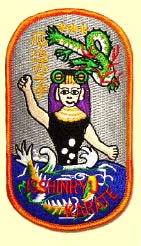
 |

|
|
Isshinryu style patch |
I've been studying karate off and on ever since my college years. I was a bookish lad in high school, not at all athletic, and hated physical education. But when I went to Pennsylvania State University as a new freshman, my roommate was studying for law enforcement and got excited about taking a karate class. He got me interested, too, and I started taking classes. While he soon dropped out from boredom, I found myself drawn to the discipline and the mix of Zen mysticism, physical exercise, and the mystique of being able to do something reserved for James Bond or any other secret agent. I continued with the classes all through my college career and think of myself as having graduated with a degee in English literature and a black belt in karate.
The style taught at the university (actually through a campus club, because there was no faculty-led course at the time) was Isshinryu. This is a style more popular on the East Coast than in the West. The teacher was Sensei James Morabeto, who drove up from his dojo in Pittsburgh to State College every Sunday night during the term to hold the classes, while the senior belts on campus ran a midweek class on Wednesday nights. Sensei Morabeto had trained with Master Tatsuo Shimabuku of Okinawa, who created the Isshinryu style, when the master visited the U.S. in the early 1960s. So, in a sense, I got my belt at two removes from the originator.
In those days karate was not something everyone learned. We were spared the embarrassment of what later became the cultural take on all such martial arts: some fool with six weeks of training under his white belt leaping about in fantastic poses making screech noises and shouting “I know karate!”—and getting knocked over by some drunk with a chair. I studied karate, but I've never needed it. I'm still a bookish lad who doesn't go in for bar fights, frequent the dangerous parts of town, or travel on secret missions for the government. But doing the exercises, called katas or forms, is a great way to get a cardio workout, keep your joints limber, improve your balance, and be doing something just a little bit harder and more mysterious than a spin class. And, you never know, I might one day meet a drunk with a chair.
From various websites, I've discovered that someone had kept and converted the original home movies that were taken of Master Shimabuku in the 1960s, performing the 13 katas that comprise the style as I learned it. I've copied them here as a tribute to the master and to the style, and in case anyone is interested in seeing what real karate discipline is all about. The first eight are hand-and-foot katas, while the last five alternate between the staff or bo and the paired short swords or sai.1
13. Shi Shi No Kon No Dai Kata
1. Sai have recently become just a bit popular in the movies. They are the swords wielded by the two Egyptian princesses in The Mummy Returns, although they were never used in ancient Egypt, being Okinawan peasant weapons adapted from the head of a pitchfork. Sai were also the favored weapon of Jennifer Garner in Elektra, who was depicted as having trained in oriental martial arts.